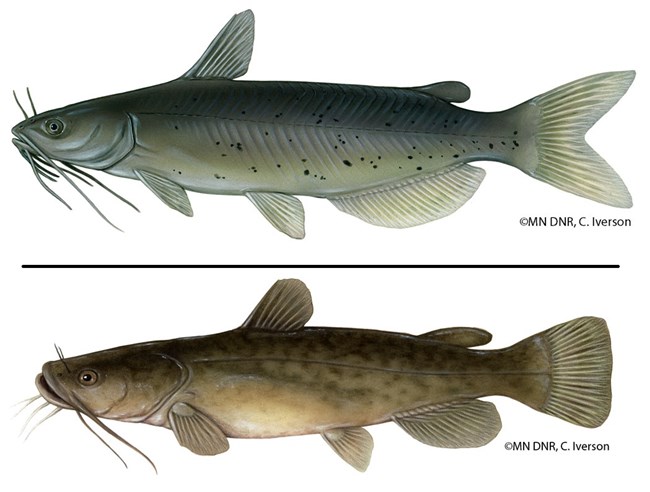
(c) MN DNR, C. Iverson IntroductionIf the Mississippi River has an iconic fish, it is probably the catfish. Two of these whiskered species patrol the depths of the river here. The smaller channel catfish favor deep pools, moving into riffles in evening to feed. Flathead catfish also like deep pools but prefer those with log jams or other dense cover. Flathead catfish can reach 29-30 inches in length, compared with the channel cats that average 10-20 inches. Although tolerant of turbid (cloudy) water and warm water temperatures, catfish prefer clean streams and require well oxygenated water. Question: What do catfish like about living here? Channel catfish feed on just about anything they can find. Anglers often go after them with smelly baits such as fermented cow’s liver. Flathead catfish are fish eaters, using sense of smell and vibration to hunt down their prey. Successful angers generally use live fish or gobs of nightcrawlers to attract flatheads. Both species use nesting cavities, such as hollow logs, log jams, and undercut banks for its eggs. Male flatheads guard their eggs and fans water over them until they hatch. In big-river wintering areas, channel cat and flathead may be found side by side. Catfish are sought by both commercial fishermen and sport anglers. Fascinating Facts
IdentificationBoth flathead and channel catfish have bullet-shaped head, long body, smooth scaleless skin, and eight barbels around the mouth (four on the upper jaw and four below). Size, tail, jaw, and color distinguish flathead from channel catfish. Channel Catfish:
Flathead Catfish:
Present in Park: Yes Habitat: Deep pools of large rivers or impoundments MN Status: Sport fish (both flathead and channel species) For Further ReadingMinnesota Department of Natural Resources. 2017. “Catfish Biology and Identification.” Accessed May 5. http://www.dnr.state.mn.us/fish/catfish/biology.html |
Last updated: November 22, 2019
